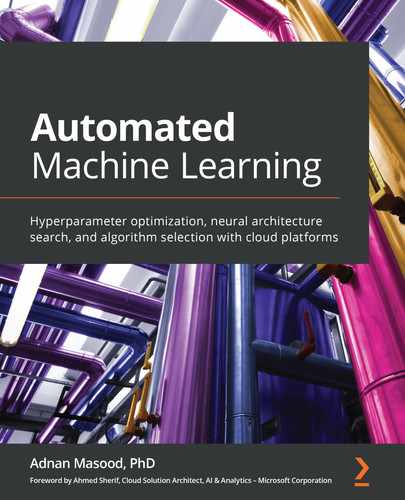Get to grips with automated machine learning and adopt a hands-on approach to AutoML implementation and associated methodologies Every machine learning engineer deals with systems that have hyperparameters, and the most basic task in automated machine learning (AutoML) is to automatically set these hyperparameters to optimize performance. The latest deep neural networks have a wide range of hyperparameters for their architecture, regularization, and optimization, which can be customized effectively to save time and effort. This book reviews the underlying techniques of automated feature engineering, model and hyperparameter tuning, gradient-based approaches, and much more. You'll discover different ways of implementing these techniques in open source tools and then learn to use enterprise tools for implementing AutoML in three major cloud service providers: Microsoft Azure, Amazon Web Services (AWS), and Google Cloud Platform. As you progress, you'll explore the features of cloud AutoML platforms by building machine learning models using AutoML. The book will also show you how to develop accurate models by automating time-consuming and repetitive tasks in the machine learning development lifecycle. By the end of this machine learning book, you'll be able to build and deploy AutoML models that are not only accurate, but also increase productivity, allow interoperability, and minimize feature engineering tasks. Citizen data scientists, machine learning developers, artificial intelligence enthusiasts, or anyone looking to automatically build machine learning models using the features offered by open source tools, Microsoft Azure Machine Learning, AWS, and Google Cloud Platform will find this book useful. Beginner-level knowledge of building ML models is required to get the best out of this book. Prior experience in using Enterprise cloud is beneficial.Key Features
Book Description
What you will learn
Who this book is for
Table of Contents
- Automated Machine Learning
- Foreword
- Contributors
- About the author
- About the reviewer
- Preface
- Section 1: Introduction to Automated Machine Learning
- Chapter 1: A Lap around Automated Machine Learning
- The ML development life cycle
- Automated ML
- How automated ML works
- Hyperparameters
- The need for automated ML
- Democratization of data science
- Debunking automated ML myths
- Myth #1 – The end of data scientists
- Myth #2 – Automated ML can only solve toy problems
- Automated ML ecosystem
- Open source platforms and tools
- Microsoft NNI
- auto-sklearn
- Auto-Weka
- Auto-Keras
- TPOT
- Ludwig – a code-free AutoML toolbox
- AutoGluon – an AutoML toolkit for deep learning
- Featuretools
- H2O AutoML
- Commercial tools and platforms
- DataRobot
- Google Cloud AutoML
- Amazon SageMaker Autopilot
- Azure Automated ML
- H2O Driverless AI
- The future of automated ML
- The automated ML challenges and limitations
- A Getting Started guide for enterprises
- Summary
- Further reading
- Chapter 2: Automated Machine Learning, Algorithms, and Techniques
- Chapter 3: Automated Machine Learning with Open Source Tools and Libraries
- Section 2: AutoML with Cloud Platforms
- Chapter 4: Getting Started with Azure Machine Learning
- Chapter 5: Automated Machine Learning with Microsoft Azure
- Chapter 6: Machine Learning with AWS
- Chapter 7: Doing Automated Machine Learning with Amazon SageMaker Autopilot
- Technical requirements
- Creating an Amazon SageMaker Autopilot limited experiment
- Creating an AutoML experiment
- Running the SageMaker Autopilot experiment and deploying the model
- Invoking the model
- Building and running SageMaker Autopilot experiments from the notebook
- Hosting and invoking the model
- Summary
- Further reading
- Chapter 8: Machine Learning with Google Cloud Platform
- Chapter 9: Automated Machine Learning with GCP
- Section 3: Applied Automated Machine Learning
- Chapter 10: AutoML in the Enterprise
- Does my organization need automated ML?
- Clash of the titans – automated ML versus data scientists
- Automated ML – an accelerator for enterprise advanced analytics
- The democratization of AI with human-friendly insights
- Augmented intelligence
- Automated ML challenges and opportunities
- Not having enough data
- Model performance
- Domain expertise and special use cases
- Computational costs
- Embracing the learning curve
- Stakeholder adaption
- Establishing trust – model interpretability and transparency in automated ML
- Feature importance
- Counterfactual analysis
- Data science measures for model accuracy
- Pre-modeling explainability
- During-modeling explainability
- Post-modeling explainability
- Introducing automated ML in an organization
- Brace for impact
- Choosing the right automated ML platform
- The importance of data
- The right messaging for your audience
- Call to action – where do I go next?
- References and further reading
- Why subscribe?
- Other Books You May Enjoy
